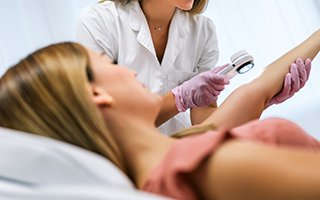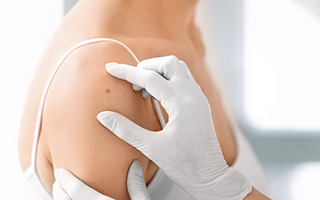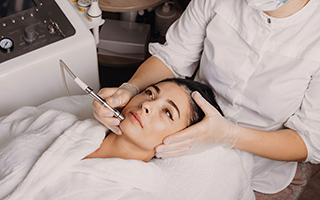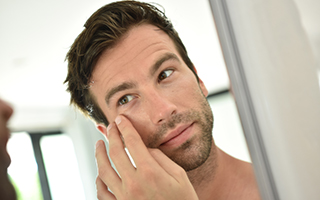Melanoma
Comprehensive Care for the Most Fatal Skin Cancer in Bryn Mawr, Newtown Square, Philadelphia, and the Main Line
The skin is your body’s largest and most visible organ. It plays an important role in various biological functions, including regulating internal temperature and forming a protective barrier against harmful environmental elements. Unfortunately, skin cancer can compromise the skin’s health—as well as spread to other areas of the body. Bryn Mawr Skin & Cancer Institute, serving Bryn Mawr, Newtown Square, and all of the Main Line, provides support for the challenges associated with these cancers, including the potentially fatal skin cancer, malignant melanoma. Philadelphia-area residents can get diagnoses, tests, and advanced treatment techniques from our experienced dermatologists.
If you would like to learn more about treatment options for melanoma, contact the dermatologists at Bryn Mawr Skin & Cancer Institute. To schedule an appointment, Please BOOK ONLINE, call 610.525.5028, or Contact Us.
What is Melanoma?
Skin cancers can be separated into two different categories: melanoma and non-melanoma. Melanoma, also known as malignant melanoma and cutaneous melanoma, is a much less common cancer of the skin, but is considered to be the most dangerous. Melanoma’s chance of spreading to other body parts is significantly high, and it can be fatal if it isn’t treated in its earliest stages.
What Causes Melanoma?
This skin disease begins in the melanocytes, which are cells that give your skin its pigment by producing melanin to protect the deeper layers against damage from ultraviolet (UV) radiation in sunlight. Previously healthy melanocytes can begin to mutate and grow uncontrollably as a result of DNA damage. UV radiation is believed to be what usually causes such damage, but genetic or other environmental factors may also play a role. These abnormal cells eventually form cancerous tumors.
There are several known risk factors that may make it more likely for patients to develop melanoma. These include exposure to UV radiation from sunlight or artificial sources, such as indoor tanning; having many moles or atypical moles; having fair skin, blond or red hair, and blue eyes; a family history of the disease; inherited genetic conditions; age; a weakened or suppressed immune system; and a history of severe sunburns.
What Are the Symptoms of Melanoma?
The first sign of melanoma might be a skin irregularity that seems to be changing in appearance and doesn’t go away over time. Sometimes a new spot may appear on the skin, or an existing mole may look and feel different from the others around it. The “ABCDEs” and the “Ugly Ducking” sign can help you know what to look for when you’re examining your skin:
- A is for Asymmetry: If you were to draw a line down the center of a normal, healthy mole, the two sides would match. Cancerous lesions are typically more irregularly shaped.
- B is for Border: Instead of an even border, the outer edge might be scalloped, notched, or indistinct.
- C is for Color: Although melanomas can look black, brown, and tan, unusual colors like red, white, and blue may be present.
- D is for Diameter: Watch out for any mole that is larger than the size of a pencil eraser.
- E is for Evolving: If you are noticing new symptoms such as bleeding, oozing, itching, or crusting, or changes to the texture or color of the mole, this could indicate the presence of cancer.
Most moles on your skin will look similar to each other. The “Ugly Duckling” strategy involves checking for any moles that look radically different or are isolated from the rest.
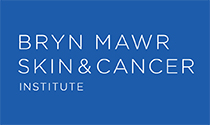
Meet Our Dermatologists &
Certified Physician Assistants
Our board-certified dermatologists & PA-Cs are dedicated to detecting and treating skin cancers. We treat the full spectrum of skin diseases. Our Mohs and Plastic Surgery practices are integrated, and offer patients the most advanced skin cancer treatment, delivering superior outcomes.
Prevention Tips for Melanoma
Although you can’t completely remove your chances of developing melanoma, there are steps that can be taken to significantly decrease the risk. Reduce the amount of time you expose yourself to UV radiation from sunlight during the daytime hours when the sun is strongest, wear broad-spectrum SPF 30+ sunscreen, use sun-protective clothing, and don’t use artificial, indoor tanning devices.
You don’t have to stay out of the sun to be safe. Just remember to:
- Slip on protective clothing.
- Slop on sunscreen with SPF 30+.
- Slap on a hat with a wide brim to shade the head, face, ears, and neck.
- Seek shade or shelter, especially during midday hours (10 a.m.-4 p.m.).
- Slide on wrap-around sunglasses.
- Swallow Heliocare Ultra.
Treatment Options for Melanoma
There are various treatment options available, which are based upon how advanced the melanoma is, the patient’s overall health, and potential side effects from therapy. Melanoma is often treated with surgical techniques, such as Mohs surgery (only for specific types and locations) and excision. We may also refer you to an oncologist for further evaluation and management.
More Skin Cancer Resources
The Bryn Mawr Skin & Cancer team also diagnoses and treats nonmelanoma cancers, like basal cell carcinoma and squamous cell carcinoma.
If you would like to learn more about how to identify and treat melanoma, contact Bryn Mawr Skin & Cancer Institute on the Main Line, serving Bryn Mawr, Newtown Square, and Philadelphia. To schedule an appointment, Please BOOK ONLINE, call 610.525.5028, or Contact Us.




